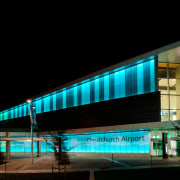Smart, award-winning, artesian-based heating and cooling system designed by Beca
Energy-saving artesian-based heating and cooling system by Beca features in many Canterbury projects, including Christchurch International Airport

A Christchurch innovation is establishing a new benchmark for artesian-based heating and cooling systems.
Christchurch International Airport and Beca are making smart use of the artesian water that flows beneath Christchurch and the Canterbury Plains to provide energy efficiencies, reduced carbon emissions and lower operating costs.
The innovation has attracted both national and international industry recognition, having won International Project of the Year at the 2015 CIBSE Building Performance Awards in London. The project also received recognition in the Building and Construction category at the 2014 IPENZ (Institution of Professional Engineers New Zealand) Engineering Excellence Awards, and a Gold Award of Excellence at the 2014 ACENZ (Association of Consulting Engineers) Innovate NZ Awards.
In 2004, Christchurch Airport embarked on a $237 million Integrated Terminal Project (ITP) to replace the original 1960s building and cater for future growth. The ethos sustainable, energy-efficient operations underpinned the development of a new 30,000m², three-storey, diamond-shaped, integrated terminal building.
A key feature of the development is the award-winning artesian heating and cooling system designed and delivered by engineering consultant Beca. The system regulates the terminal building's temperature, improving the experience of the millions of passengers who pass through the airport each year.

The existing international terminal building used artesian water in a pre-cooling application, pumping water directly through pre-cooling coils and, at the start of the project, it was envisaged that the new terminal building would use a similar system.
Beca believed the artesian water had more to offer and more could be done to make better use of this sustainable resource. Thinking further, we found the artesian water, which has a fairly constant year-round temperature of 12°C, would lend itself well to a heat pump-type system. With such a system we could not only reject heat energy to the aquifer, but also take heat energy for heating.
Once extracted, the artesian water passes through heat exchangers that increase or decrease the water's temperature to extract or reject heat energy. Cooling the water provides heating to the building (by extracting heat energy), while heating the water provides cooling to the building (by rejecting heat energy). The work is done by relatively standard air-conditioning equipment. When conditions suit, this equipment can be bypassed to further enhance performance.
The heat exchangers create a physical separation between the artesian water and the building's water supply to eliminate the risk of contamination of the artesian water. Afterwards, the water is returned in the same condition it was taken (with only the temperature altered).
Every aspect of the system's design was analysed, challenged and developed to maximise energy efficiency and sustainability, with the end result dramatically reducing Christchurch Airport's energy consumption, carbon emissions, operational costs and dependency on fossil fuels.

An early independent review predicted that while the new terminal occupies 55% more space than its predecessor, the heating and cooling system reduced energy use per square metre by 40% and is expected to reduce total overall energy consumption of the combined international and domestic terminal buildings by 2%.
Christchurch Airport's terminal facilities manager Mike Parker says the system's refinement is undeniable. He says that since the system was commissioned, it has not missed a beat. It has exceeded energy performance expectations the thermal comfort through the new terminal is fantastic, even on the coldest and hottest days.
Beca engineers also had to overcome the challenge of maintaining continuous airport operations throughout the entire project, as the new building sat largely across the old building footprint. Beca technical director and Christchurch building services manager Justin Hill says the staging of demolition and construction was continuously rethought, tested and questioned to provide the best outcome.
The artesian heating and cooling system is scalable and can be adapted to other buildings or applications. Various Christchurch projects are now incorporating artesian-based heating and cooling systems, including the new Terrace development, Environment Canterbury office building, the Arts Centre, Bus Exchange and Justice Precinct. It is also the recommended solution for the Metro Sports Facility and the Christchurch Convention Centre, as well as being at the core of the proposed District Energy System.
The Energy Efficiency and Conservation Authority and the Christchurch City Council are both providing grants to promote the use of this type of system. Christchurch Airport is also working to install a new artesian heating and cooling system within the existing international terminal building.
Story by: Trendsideas
Home kitchen bathroom commercial design
Commercial Design Trends Vol. 31/7
Commercial Design Trends is aimed at our professional readers, and showcases commercial buildings. The book features reg...
Read More



